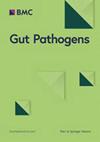作为感染生物学标准化模型的结构化多细胞肠球(SMIS)
IF 4.3
3区 医学
Q1 GASTROENTEROLOGY & HEPATOLOGY
引用次数: 0
摘要
近来,三维细胞培养模型在复制器官微结构和诱导类似活体反应方面日益受到关注,在各生物学科中大有可为。从广义上讲,三维细胞培养包括有机体以及单细胞和多细胞球体。后者已成功应用于肿瘤研究,但用于感染生物学的、能模拟肠道微观结构的标准化肠道模型却明显缺乏。因此,本研究旨在开发结构化多细胞肠球体(SMIS),专门用于研究肠道病原体感染的分子基础。我们成功地设计出了由四种相关细胞类型组成的人类 SMIS,其特点是以成纤维细胞为核心,外层包裹着单层肠细胞、鹅口疮细胞和单核细胞。这些SMIS有效地模拟了体内肠粘膜表面的结构,并在短短两天的培养过程中表现出分化的形态特征,包括微绒毛的存在。通过对各种分化因子的分析,我们发现与二维单层相比,这些球体的分化水平更高。此外,SMIS 还是一种优化的肠道感染模型,超越了传统二维培养物的能力,并表现出与空肠弯曲菌感染后体内感染类似的免疫标志物调节模式。值得注意的是,我们的方案不仅适用于人类球形培养物,还适用于小鼠和猪等其他物种。基于快速达到增强的分化状态,加上功能性刷状缘特征的出现、细胞复杂性的增加以及肠粘膜微结构的复制(允许通过培养基进行暴露研究),我们确信,我们的创新 SMIS 模型超越了传统的细胞培养方法,是一种卓越的模型。此外,由于方案的可扩展性和标准化能力,它比干细胞衍生的器官组织更具优势。通过展示分化的形态属性,我们的模型为各种应用提供了最佳平台。此外,与空肠弯曲杆菌感染后的单型单层相比,我们研究了几种免疫因素的差异,强调了我们的球体模型的完善性,它密切模拟了体内感染的重要特征。本文章由计算机程序翻译,如有差异,请以英文原文为准。
Structured multicellular intestinal spheroids (SMIS) as a standardized model for infection biology
3D cell culture models have recently garnered increasing attention for replicating organ microarchitecture and eliciting in vivo-like responses, holding significant promise across various biological disciplines. Broadly, 3D cell culture encompasses organoids as well as single- and multicellular spheroids. While the latter have found successful applications in tumor research, there is a notable scarcity of standardized intestinal models for infection biology that mimic the microarchitecture of the intestine. Hence, this study aimed to develop structured multicellular intestinal spheroids (SMIS) specifically tailored for studying molecular basis of infection by intestinal pathogens. We have successfully engineered human SMIS comprising four relevant cell types, featuring a fibroblast core enveloped by an outer monolayer of enterocytes and goblet cells along with monocytic cells. These SMIS effectively emulate the in vivo architecture of the intestinal mucosal surface and manifest differentiated morphological characteristics, including the presence of microvilli, within a mere two days of culture. Through analysis of various differentiation factors, we have illustrated that these spheroids attain heightened levels of differentiation compared to 2D monolayers. Moreover, SMIS serve as an optimized intestinal infection model, surpassing the capabilities of traditional 2D cultures, and exhibit a regulatory pattern of immunological markers similar to in vivo infections after Campylobacter jejuni infection. Notably, our protocol extends beyond human spheroids, demonstrating adaptability to other species such as mice and pigs. Based on the rapid attainment of enhanced differentiation states, coupled with the emergence of functional brush border features, increased cellular complexity, and replication of the intestinal mucosal microarchitecture, which allows for exposure studies via the medium, we are confident that our innovative SMIS model surpasses conventional cell culture methods as a superior model. Moreover, it offers advantages over stem cell-derived organoids due to scalability and standardization capabilities of the protocol. By showcasing differentiated morphological attributes, our model provides an optimal platform for diverse applications. Furthermore, the investigated differences of several immunological factors compared to monotypic monolayers after Campylobacter jejuni infection underline the refinement of our spheroid model, which closely mimics important features of in vivo infections.
求助全文
通过发布文献求助,成功后即可免费获取论文全文。
去求助
来源期刊

Gut Pathogens
GASTROENTEROLOGY & HEPATOLOGY-MICROBIOLOGY
CiteScore
7.70
自引率
2.40%
发文量
43
期刊介绍:
Gut Pathogens is a fast publishing, inclusive and prominent international journal which recognizes the need for a publishing platform uniquely tailored to reflect the full breadth of research in the biology and medicine of pathogens, commensals and functional microbiota of the gut. The journal publishes basic, clinical and cutting-edge research on all aspects of the above mentioned organisms including probiotic bacteria and yeasts and their products. The scope also covers the related ecology, molecular genetics, physiology and epidemiology of these microbes. The journal actively invites timely reports on the novel aspects of genomics, metagenomics, microbiota profiling and systems biology.
Gut Pathogens will also consider, at the discretion of the editors, descriptive studies identifying a new genome sequence of a gut microbe or a series of related microbes (such as those obtained from new hosts, niches, settings, outbreaks and epidemics) and those obtained from single or multiple hosts at one or different time points (chronological evolution).
 求助内容:
求助内容: 应助结果提醒方式:
应助结果提醒方式:


